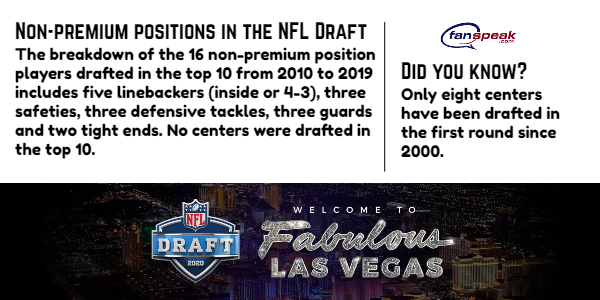NFL Mock Draft Tips: When it comes to tie-breakers, go with the premium position

As part of an occasional series, Fanspeak will offer tips and best practices for its wildly popular and first-of-its-kind On The Clock draft simulator.
Today’s topic: When in doubt, draft the player at the premium position.
Here’s a cringe-worthy situation you’re probably familiar with:
It’s your turn to draft, and your team’s biggest need is at pass rusher, although you also need a tight end. Since your team is drafting somewhere in the middle of the first round, the top two pass rushers have already been selected.
The dilemma you face:
- It’s considered a light year for pass rushers, so if you don’t draft one in the first round, then you’re unlikely to fill that position of need with an impact rookie.
- You need a tight end, but the highest-ranked TEs are considered Day 2 talents.
Now it’s your turn to draft: Do you take the third-best pass rusher, or go with the top, but much lower-ranked, tight end?
If you’ve played Fanspeak’s On The Clock draft simulator enough times, then this cringe-worthy scenario has probably played out a few hundred times.
And you know all about the risks associated with drafting for need, taking the best player available and even trading down.
But in this particular scenario, your answer is simple: Draft the premium position.
Premium positions have the greater impact
It may fly in the face of conventional wisdom, but in the above example – taking the third-best pass rusher over the top tight end – is the smart move.
There are exceptions, of course, when dealing with blue-chip or generational-type talents at any position. In recent years, Notre Dame guard Quenton Nelson was the No. 6 overall pick; former Alabama defensive tackles Marcell Dareus (2011) and Quinnen Williams (2019) were picked third overall in their respective drafts.
Replacing the Beard will not be easy https://t.co/ryB5ARJfjf
— David Howman (@_DH44_) March 24, 2020
But only 16 out of the 100 players drafted in the top-10 between 2010 to 2019 have played a position other than quarterback, offensive tackle, pass rusher, cornerback, wide receiver or running back. (While it’s debatable whether receiver and running back are considered “premium” positions due to the high volume of quality talent at receiver and the trend away from run-heavy offenses, both are considered skill positions, so they are included in the list of “premium” positions.)
That alone tells you the value teams place on premium vs. non-premium positions.
What the stats say
For example, four tight ends ranked among the top 20 last season in receptions and only two ranked in the top 20 for yards. Linebackers and safeties made up the entire list of top 20 leading tacklers in 2019, but no traditional, 4-3 linebacker cracked the top 20 in sacks (only three defensive linemen ranked in the top 20, too), and only seven safeties had four or more interceptions last year and only two ranked among the top 20 in passes defended.
Simply put, the big money goes to the players who make the most splash plays or protect the quarterback. NFL salaries bear that out, too. That’s because, in theory, those players have the biggest impact on their teams, with just a few exceptions.
Jake Rigdon (jake@sydwriting.com) covers the NFL draft for Fanspeak and the On The Clock, which is the only NFL draft simulator that allows you to customize and use your own big board while giving you control over trades.

